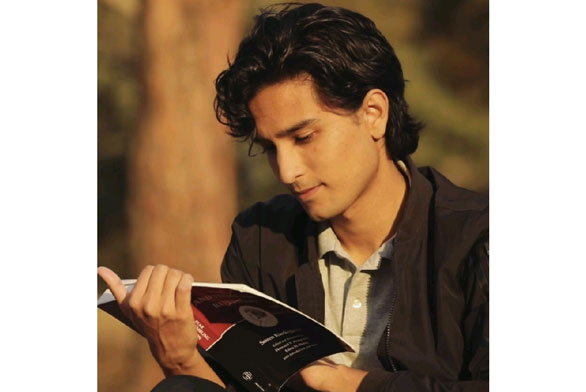Aayush Thapa (SF22) Goes from SJC Internship to Los Alamos National Labs
November 4, 2022 | By Frank O’Mahony

Aayush Thapa (SF22) wakes up at the break of dawn and is soon off on his hour-long commute to Los Alamos National Laboratory (LANL) where he works as a post-bachelor researcher. “It’s a demanding schedule, but there is a comfort in the regularity and order of the workday,” he says.
He works in the Los Alamos Neutron Science Center (LANSCE), a particle physics division of LANL, where he also completed his ARIEL internship in summer 2022. Working at one of the top scientific institutions in the country is in many ways its own reward, but Thapa also has other things he wishes to gain from this experience.
“At first, I wasn’t so sure I wanted to do science, or would even be able to keep up with high-level research,” he says. “As robust as the math and lab programs at the college are, they don’t deal with any contemporary research. So you’re walking around with a large gap in knowledge about contemporary research interests and methods in science, not to mention advanced computing.”
Most of his everyday duties entail upkeep of physical and cyber components of a 10-ton liquid argon detector. In the longer term, he expects to conduct actual analyses for his collaboration.
“I work for a collaboration called Coherent CAPTAIN-Mills, an extensive agglomeration of labs and university departments, the crown jewel of which is a detector housed in LANSCE itself. The aim of the collaboration and the detector is to prove the existence of dark matter in a specific context of its posited interaction with ordinary particles that we know and recognize,” he says.
The experiment could provide relatively conclusive evidence of—and further information about—the identity of dark matter. This would prove to be a paradigm shift in our thinking about physics and the universe.
Thapa describes the barriers of entry into the field of particle physics and dark matter search as “quite high.” He is thankful to be part of a collaboration that has the resources and patience to accommodate someone like himself, who has very little background in this type of research.
“I had not only to update my scientific knowledge, which was limited, if helpful, but I had also to learn two new programming languages from scratch,” Thapa says. “But because I spent the summer on an ARIEL I found I had the time to do most of that learning so that I could be ready for my job when it started. And, of course, the boldness planted by St. John’s in approaching any subject cannot be understated.”
Thapa knows that some might find his casual interest in particle physics and dark matter unusual. “Think of this as the natural consequence of a St. John’s education,” he says. “The fields in which one could specialize represent a parcel of knowledge, and why would you settle for a parcel when you could have the whole huge plate? Philosophy, for me, is the plate and particle physics the parcel.”
“Do not get me wrong—you cannot do philosophy completely detached from other fields of knowledge, especially science. What is more, it is impossible to understand the contemporary worldview without a thorough grasp of science, which is largely responsible for putting this worldview in place.”
Thapa hopes that time spent conducting research at LANL will help him with the larger questions that he developed during his time at St. John’s—both directly and indirectly. While writing his senior essay on Plato’s Theaetetus, he had the chance to think about science in its earliest manifestation.
“In many ways Protagoras, whose theories feature in the first part of the dialogue, is a kind of proto scientist,” says Thapa. “The hypothesis closely echoes the theories we have today in neuroscience, biology, and even in quantum physics, though it also has its differences. The dialogue and my paper, however, show why Protagoras’ theory, while being partly correct, cannot be the whole story and actually fails as a full account of experience. That realization lit a fire in me to go out into the world and deal with other narratives about how the world works—scientific ones, especially in order to sift the true from the fanciful.”
Time in the St. John’s lab also pushed him in this direction. The very first practicum conducted by freshmen is a classification project involving pine needles. The practicum ushers in for the students not only a keen eye and enthusiasm for close examination of our natural surroundings, but also awakens them to the variability of scientific convention.
Many practicum groups come up with their own elaborate and sound classification systems for pine needles. These systems do not resemble modern conventional taxonomies. Thapa claims that this kind of “looking,” with an eye to understand and classify, reconnects the human not only to nature but to the scientific understanding he seeks.
Dark matter to Thapa is fascinating, both theoretically, and phenomenally. “We have important evidence that what we can actually see only makes up a sliver of the actual matter content of the universe, the rest being this invisible matter for which we still await experimental confirmation. The looking involved in dark-matter search, therefore, cannot be literal. It is mediated by thousands of years of mathematical development and computational ability—it is ‘seen’ only through its effects.”
But Thapa claims, this is a looking nonetheless—a kind of looking that requires a keen and unprejudiced but also trained eye. He feels that this is where a Johnnie is at home.

